国外屋顶绿化植物品种选择
- 格式:pdf
- 大小:1.76 MB
- 文档页数:9
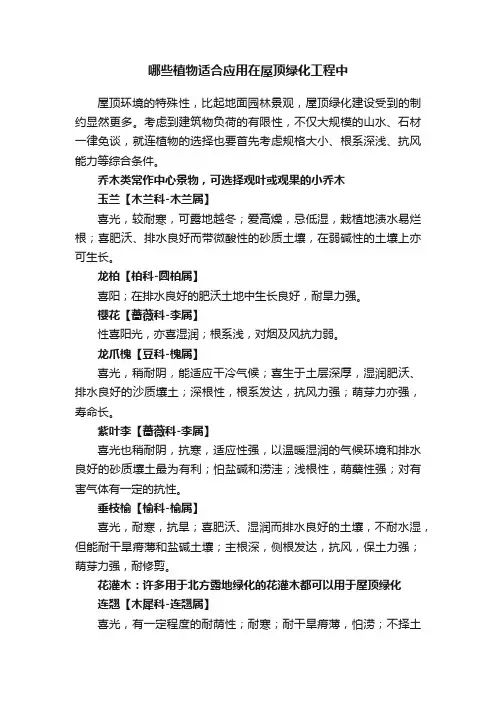
哪些植物适合应用在屋顶绿化工程中屋顶环境的特殊性,比起地面园林景观,屋顶绿化建设受到的制约显然更多。
考虑到建筑物负荷的有限性,不仅大规模的山水、石材一律免谈,就连植物的选择也要首先考虑规格大小、根系深浅、抗风能力等综合条件。
乔木类常作中心景物,可选择观叶或观果的小乔木玉兰【木兰科-木兰属】喜光,较耐寒,可露地越冬;爱高燥,忌低湿,栽植地渍水易烂根;喜肥沃、排水良好而带微酸性的砂质土壤,在弱碱性的土壤上亦可生长。
龙柏【柏科-圆柏属】喜阳;在排水良好的肥沃土地中生长良好,耐旱力强。
樱花【蔷薇科-李属】性喜阳光,亦喜湿润;根系浅,对烟及风抗力弱。
龙爪槐【豆科-槐属】喜光,稍耐阴,能适应干冷气候;喜生于土层深厚,湿润肥沃、排水良好的沙质壤土;深根性,根系发达,抗风力强;萌芽力亦强,寿命长。
紫叶李【蔷薇科-李属】喜光也稍耐阴,抗寒,适应性强,以温暖湿润的气候环境和排水良好的砂质壤土最为有利;怕盐碱和涝洼;浅根性,萌蘖性强;对有害气体有一定的抗性。
垂枝榆【榆科-榆属】喜光,耐寒,抗旱;喜肥沃、湿润而排水良好的土壤,不耐水湿,但能耐干旱瘠薄和盐碱土壤;主根深,侧根发达,抗风,保土力强;萌芽力强,耐修剪。
花灌木:许多用于北方露地绿化的花灌木都可以用于屋顶绿化连翘【木犀科-连翘属】喜光,有一定程度的耐荫性;耐寒;耐干旱瘠薄,怕涝;不择土壤;抗病虫害能力强。
榆叶梅【蔷薇科-梅属】温带树种,耐寒,耐旱、喜光;对土壤的要求不严,但不耐水涝,喜中性至微碱性、肥沃、疏松的砂壤土。
矮生紫薇【千屈菜科-紫薇属】生长快,抗性强,耐寒、耐旱、耐盐碱,耐瘠薄,管理粗放。
黄栌【漆树科-黄栌属】喜光,也耐半荫;耐寒,耐干旱瘠薄和碱性土壤,但不耐水湿;以深厚、肥沃而排水良好的沙壤土生长最好;根系发达,萌蘖性强,生长快;对二氧化硫有较强抗。
金银木【忍冬科-忍冬属】喜光,耐半阴,耐旱,耐寒;喜湿润肥沃及深厚之土壤;管理粗放,病虫害少。
紫叶矮樱【蔷薇科-李属】喜光,耐寒;适应性强,对土壤要求不严格,在排水良好、肥沃的砂壤土、轻度粘土上生长良好;根系发达,吸收力强,抗病力强,耐修剪。

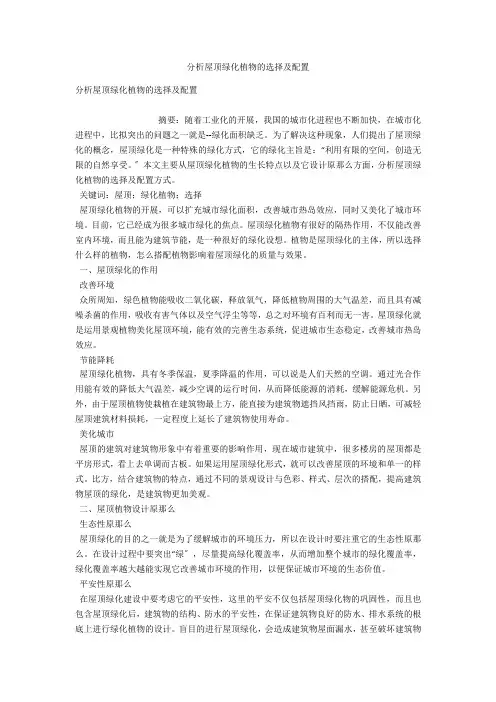
分析屋顶绿化植物的选择及配置分析屋顶绿化植物的选择及配置摘要:随着工业化的开展,我国的城市化进程也不断加快,在城市化进程中,比拟突出的问题之一就是--绿化面积缺乏。
为了解决这种现象,人们提出了屋顶绿化的概念,屋顶绿化是一种特殊的绿化方式,它的绿化主旨是:“利用有限的空间,创造无限的自然享受。
〞本文主要从屋顶绿化植物的生长特点以及它设计原那么方面,分析屋顶绿化植物的选择及配置方式。
关键词:屋顶;绿化植物;选择屋顶绿化植物的开展,可以扩充城市绿化面积,改善城市热岛效应,同时又美化了城市环境。
目前,它已经成为很多城市绿化的焦点。
屋顶绿化植物有很好的隔热作用,不仅能改善室内环境,而且能为建筑节能,是一种很好的绿化设想。
植物是屋顶绿化的主体,所以选择什么样的植物,怎么搭配植物影响着屋顶绿化的质量与效果。
一、屋顶绿化的作用改善环境众所周知,绿色植物能吸收二氧化碳,释放氧气,降低植物周围的大气温差,而且具有减噪杀菌的作用,吸收有害气体以及空气浮尘等等,总之对环境有百利而无一害。
屋顶绿化就是运用景观植物美化屋顶环境,能有效的完善生态系统,促进城市生态稳定,改善城市热岛效应。
节能降耗屋顶绿化植物,具有冬季保温,夏季降温的作用,可以说是人们天然的空调。
通过光合作用能有效的降低大气温差,减少空调的运行时间,从而降低能源的消耗,缓解能源危机。
另外,由于屋顶植物使栽植在建筑物最上方,能直接为建筑物遮挡风挡雨,防止日晒,可减轻屋顶建筑材料损耗,一定程度上延长了建筑物使用寿命。
美化城市屋顶的建筑对建筑物形象中有着重要的影响作用,现在城市建筑中,很多楼房的屋顶都是平房形式,看上去单调而古板。
如果运用屋顶绿化形式,就可以改善屋顶的环境和单一的样式。
比方,结合建筑物的特点,通过不同的景观设计与色彩、样式、层次的搭配,提高建筑物屋顶的绿化,是建筑物更加美观。
二、屋顶植物设计原那么生态性原那么屋顶绿化的目的之一就是为了缓解城市的环境压力,所以在设计时要注重它的生态性原那么。
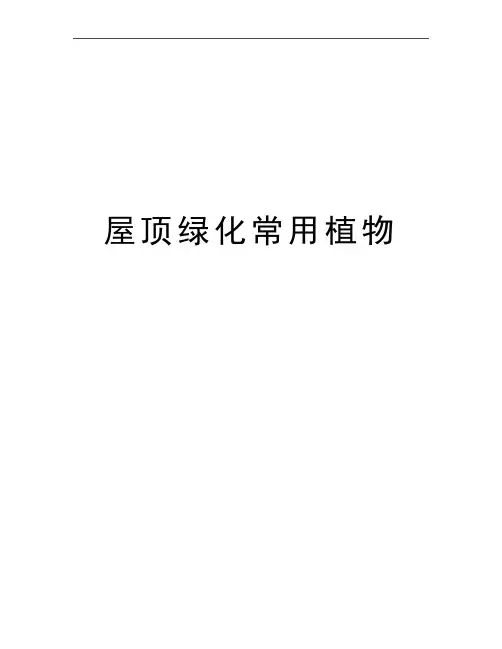
屋顶绿化常用植物屋顶绿化--常用植物1、景天科(Crassulaceae)原产地与生态习性:全世界约25属,860种以上,产地分布甚广,温带、热带、亚寒带、高山带均有分布;具有较强的适应性,是多肉植物中品种最多也是最易栽培的一科。
生物学特性:一年或多年生多肉草本或亚灌木,通常为肉质状。
叶互生、对生或轮生,单生,多数无柄,全缘,有锯齿、浅裂或羽狀裂,无托叶。
花多为两性,整齐,通常呈聚伞花序,少数呈总状花序甚或单生,黄绿色或红绿色。
果实为蓇葖果,膜质或草质,常为残存之膜质花瓣所包被,开裂;种子小,常有肉质胚乳。
重要属、种:1、景天属(sedum):多年生草本或小灌木,约350种,产于北温带,多生于岩石上或屋瓦上,中国有150余种。
叶互生稀对生。
花五出呈聚伞花序,春夏季开花。
如:佛甲草(Sedum lineare Thunb.)、垂盆草(Sedum sarmentosum Bunge)、德国景天(Sedum bybridum CV. Im-meryrunchett)等。
2、伽蓝菜属(Kalanchoe):原产于南非、马达加斯加、热带美洲及热带圈内。
多年生肉质草本。
叶轮生或交互对生,肥厚多肉,光滑或有毛,叶部全缘,或锯齿缘或羽状裂开,有的叶上有不定芽或小植株,犹如飞舞的蝴蝶,十分美丽,如不死鸟。
花为顶生圆锥花序或聚伞花序,花色鲜艳。
重要的观赏种有长寿花(K. blossfeldiana)、落地生根(K. tubifdia)、月兔耳(K. Tomentosa)等。
2、大戟科(Euphorbiaceae)原产地及生态习性:多分布于热带与亚热带地区,约有280属,8000种。
生物学特性:一年生或多年生草本、灌木或乔木。
茎多为草本,但亦有木质或成乔木的,有时成仙人掌状多刺之肉质植物,多数有乳汁状汁液,有时有肉质块根。
花单性,雌雄同株呈聚伞花序。
果为蒴果或核果。
重要属、种:大戟属(Euphorbia):此属为多肉植物约数百种。
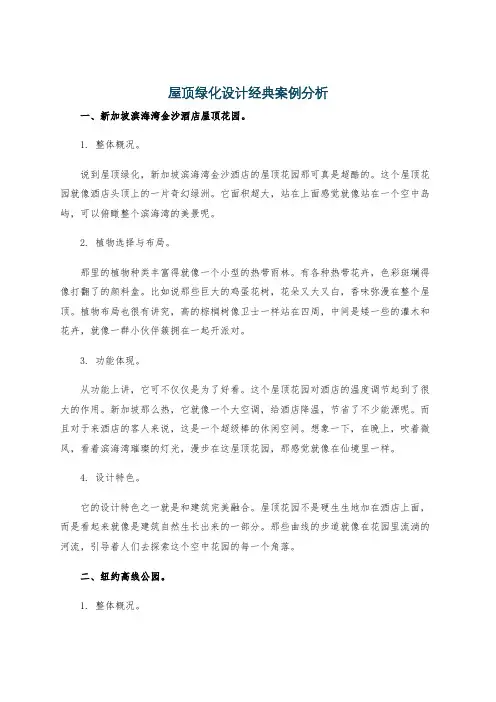
屋顶绿化设计经典案例分析一、新加坡滨海湾金沙酒店屋顶花园。
1. 整体概况。
说到屋顶绿化,新加坡滨海湾金沙酒店的屋顶花园那可真是超酷的。
这个屋顶花园就像酒店头顶上的一片奇幻绿洲。
它面积超大,站在上面感觉就像站在一个空中岛屿,可以俯瞰整个滨海湾的美景呢。
2. 植物选择与布局。
那里的植物种类丰富得就像一个小型的热带雨林。
有各种热带花卉,色彩斑斓得像打翻了的颜料盒。
比如说那些巨大的鸡蛋花树,花朵又大又白,香味弥漫在整个屋顶。
植物布局也很有讲究,高的棕榈树像卫士一样站在四周,中间是矮一些的灌木和花卉,就像一群小伙伴簇拥在一起开派对。
3. 功能体现。
从功能上讲,它可不仅仅是为了好看。
这个屋顶花园对酒店的温度调节起到了很大的作用。
新加坡那么热,它就像一个大空调,给酒店降温,节省了不少能源呢。
而且对于来酒店的客人来说,这是一个超级棒的休闲空间。
想象一下,在晚上,吹着微风,看着滨海湾璀璨的灯光,漫步在这屋顶花园,那感觉就像在仙境里一样。
4. 设计特色。
它的设计特色之一就是和建筑完美融合。
屋顶花园不是硬生生地加在酒店上面,而是看起来就像是建筑自然生长出来的一部分。
那些曲线的步道就像在花园里流淌的河流,引导着人们去探索这个空中花园的每一个角落。
二、纽约高线公园。
1. 整体概况。
纽约高线公园原本是一条废弃的铁路线,结果被聪明的设计师变成了一个超有特色的屋顶绿化(虽然严格来说是架在空中的绿化,但原理类似啦)。
这条长长的“屋顶”绿化贯穿了纽约的几个街区,就像一条绿色的丝带飘在空中。
2. 植物选择与布局。
这里的植物选择很有纽约特色,既有适应城市环境的本土植物,又有一些精心挑选的观赏植物。
草类植物在风中摇曳,就像在跳舞一样。
还有很多野生花卉,它们随意地生长,给人一种很自然、很野性的美感。
植物布局也是根据铁路线的形状来的,有的地方植物密集,像一片绿色的海洋,有的地方则留出空间,摆上了长椅,供人们休息和欣赏风景。
3. 功能体现。
高线公园的功能可多了去了。
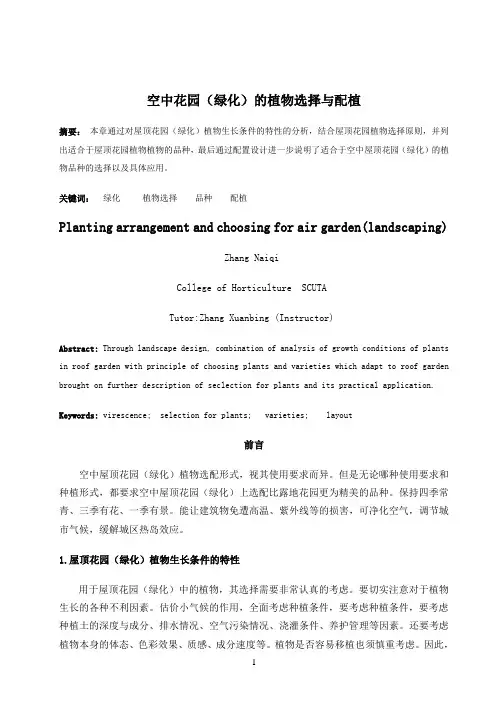
空中花园(绿化)的植物选择与配植摘要:本章通过对屋顶花园(绿化)植物生长条件的特性的分析,结合屋顶花园植物选择原则,并列出适合于屋顶花园植物植物的品种,最后通过配置设计进一步说明了适合于空中屋顶花园(绿化)的植物品种的选择以及具体应用。
关键词:绿化植物选择品种配植Planting arrangement and choosing for air garden(landscaping)Zhang NaiqiCollege of Horticulture SCUTATutor:Zhang Xuanbing (Instructor)Abstract: Through landscape design, combination of analysis of growth conditions of plants in roof garden with principle of choosing plants and varieties which adapt to roof garden brought on further description of seclection for plants and its practical application.Keywords: virescence; selection for plants; varieties; layout前言空中屋顶花园(绿化)植物选配形式,视其使用要求而异。
但是无论哪种使用要求和种植形式,都要求空中屋顶花园(绿化)上选配比露地花园更为精美的品种。
保持四季常青、三季有花、一季有景。
能让建筑物免遭高温、紫外线等的损害,可净化空气,调节城市气候,缓解城区热岛效应。
1.屋顶花园(绿化)植物生长条件的特性用于屋顶花园(绿化)中的植物,其选择需要非常认真的考虑。
要切实注意对于植物生长的各种不利因素。
估价小气候的作用,全面考虑种植条件,要考虑种植条件,要考虑种植土的深度与成分、排水情况、空气污染情况、浇灌条件、养护管理等因素。
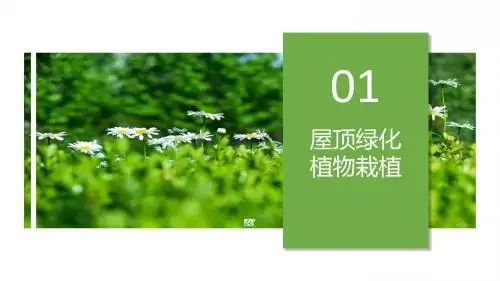
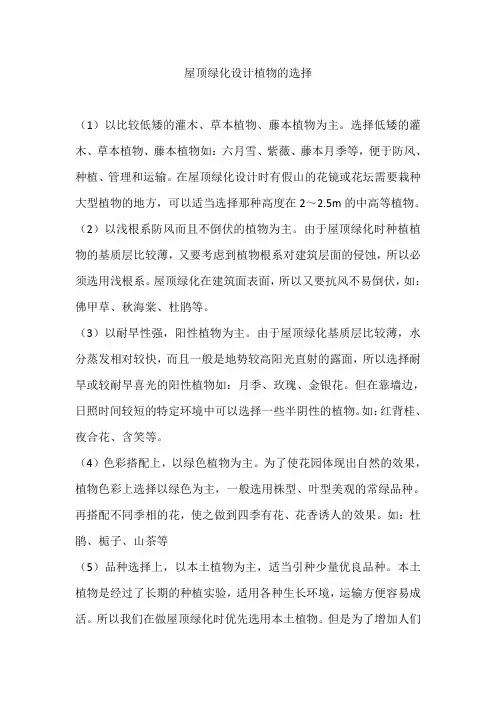
屋顶绿化设计植物的选择
(1)以比较低矮的灌木、草本植物、藤本植物为主。
选择低矮的灌木、草本植物、藤本植物如:六月雪、紫薇、藤本月季等,便于防风、种植、管理和运输。
在屋顶绿化设计时有假山的花镜或花坛需要栽种大型植物的地方,可以适当选择那种高度在2~2.5m的中高等植物。
(2)以浅根系防风而且不倒伏的植物为主。
由于屋顶绿化时种植植物的基质层比较薄,又要考虑到植物根系对建筑层面的侵蚀,所以必须选用浅根系。
屋顶绿化在建筑面表面,所以又要抗风不易倒伏,如:佛甲草、秋海棠、杜鹃等。
(3)以耐旱性强,阳性植物为主。
由于屋顶绿化基质层比较薄,水分蒸发相对较快,而且一般是地势较高阳光直射的露面,所以选择耐旱或较耐旱喜光的阳性植物如:月季、玫瑰、金银花。
但在靠墙边,日照时间较短的特定环境中可以选择一些半阴性的植物。
如:红背桂、夜合花、含笑等。
(4)色彩搭配上,以绿色植物为主。
为了使花园体现出自然的效果,植物色彩上选择以绿色为主,一般选用株型、叶型美观的常绿品种。
再搭配不同季相的花,使之做到四季有花、花香诱人的效果。
如:杜鹃、栀子、山茶等
(5)品种选择上,以本土植物为主,适当引种少量优良品种。
本土植物是经过了长期的种植实验,适用各种生长环境,运输方便容易成活。
所以我们在做屋顶绿化时优先选用本土植物。
但是为了增加人们
对屋顶植物的新鲜感,根据各地气候特点,适当引用一些优良的外地品种,丰富屋顶植物景观。
如:鱼尾葵、九里香、鸭脚木等。
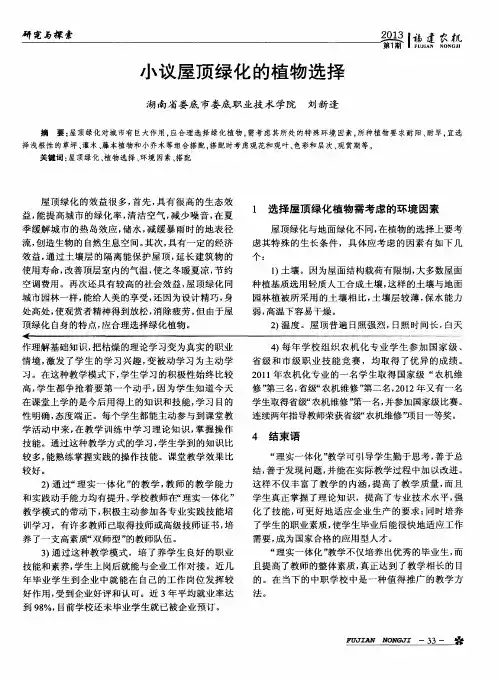

屋顶花园植物选择1.选择耐旱、抗寒性强的矮灌木和草本植物。
一般应选择阳性的、耐旱、耐寒的浅根性植物,还必须属低矮、抗风、耐移植的品种。
常见的有罗汉松、瓜子黄杨、大叶黄杨、雀舌黄杨、锦熟黄杨、珊瑚树、棕榈、蚊母、丝兰、栀子花、巴茅、龙爪槐、紫荆、紫薇、海棠、腊梅、寿星桃等,因时因地区确定使用材料。
2.选择阳性、耐瘠薄的浅根性植物。
如白玉兰、紫玉兰、天竺、杜鹃、牡丹、茶花、含笑、月季、橘子、金橘、茉莉、美人蕉、大丽花、苏铁、百合、百枝莲、鸡冠花、枯叶菊、桃叶珊瑚、海桐、构骨、葡萄、紫藤、常春藤、爬山虎、六月雪、桂花、菊花、麦冬、葱兰、黄馨、迎春、鸡蛋花、天鹅绒草坪、荷花等。
3.选择抗风、不易倒伏、耐积水的植物种类。
如大叶胡颓子、胡枝子、锐齿冬青、无刺枸骨、矮紫杉、丛生大叶女贞、法国冬青、大叶黄杨、朴树、榉树、黄栌、美国红栌等。
4.以常绿为主,冬季能露地越冬的植物。
如耐冬、山茶、中华蚊母、日本女贞、红豆杉、香樟、杜英、北美栎、广玉兰、榕树、冬青、棕榈、散尾葵、加拿大海枣、桂花、造型对接白蜡、造型黄杨、海桐、剑麻、南洋杉、凤凰木、木荷、红花木莲、含笑等。
绿地草坪以常绿草坪及麦冬草、佛甲草、果岭草为主。
景天属:佛甲草、垂盆草、凹叶景天、金叶景天等。
藤本地被类:蔓长春花、油麻常春藤等宿根草花类:石竹属、百里香属、大花金鸡菊、蓍属、紫菀属等矮花灌木类:矮生紫薇、六月雪、锦葵、木槿、小叶扶芳藤、扶桑、假连翘等灌木小乔木:白兰花、玫瑰、六月雪、石榴、红枫、南天竹、桂花、八角金盘、栀子、金丝桃、八仙花、苏铁、酒瓶兰、散尾葵等。
蔓性植物:葡萄、炮仗花、爬山虎、紫藤、凌霄、常春藤、金银花、牵牛花等;绿篱:黄杨、冬青、小檗、黄刺梅、女贞、珍珠梅、木槿等;抗污染树种:无花果、桑树、合欢、木槿、茉莉、桂花、棕榈等;花灌木:山茶、杜鹃、火棘、连翘、月季、迎春等;常绿灌木:黄金榕、变叶木、鹅掌柴等;地被植物:南方美女樱、太阳花、吊朱梅、凤尾草、天鹅绒等;北方结缕草、野牛草、丛兰、麦冬、小叶女贞等。
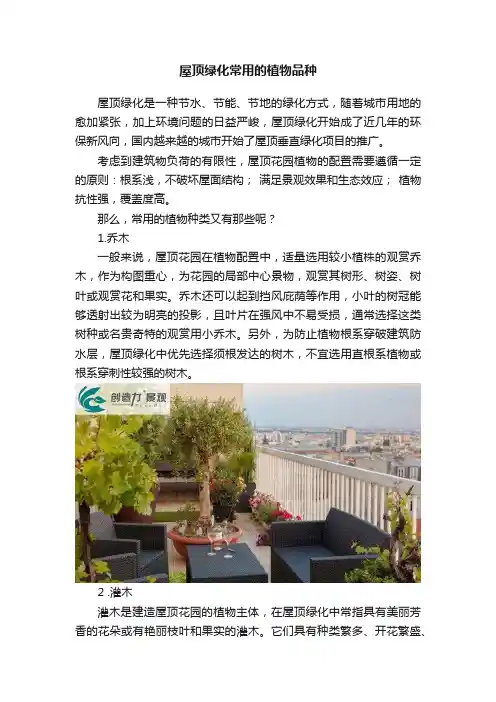
屋顶绿化常用的植物品种屋顶绿化是一种节水、节能、节地的绿化方式,随着城市用地的愈加紧张,加上环境问题的日益严峻,屋顶绿化开始成了近几年的环保新风向,国内越来越的城市开始了屋顶垂直绿化项目的推广。
考虑到建筑物负荷的有限性,屋顶花园植物的配置需要遵循一定的原则:根系浅,不破坏屋面结构;满足景观效果和生态效应;植物抗性强,覆盖度高。
那么,常用的植物种类又有那些呢?1.乔木一般来说,屋顶花园在植物配置中,适量选用较小植株的观赏乔木,作为构图重心,为花园的局部中心景物,观赏其树形、树姿、树叶或观赏花和果实。
乔木还可以起到挡风庇荫等作用,小叶的树冠能够透射出较为明亮的投影,且叶片在强风中不易受损,通常选择这类树种或名贵奇特的观赏用小乔木。
另外,为防止植物根系穿破建筑防水层,屋顶绿化中优先选择须根发达的树木,不宜选用直根系植物或根系穿刺性较强的树木。
2 .灌木灌木是建造屋顶花园的植物主体,在屋顶绿化中常指具有美丽芳香的花朵或有艳丽枝叶和果实的灌木。
它们具有种类繁多、开花繁盛、色彩鲜艳、成景快、寿命长、栽培容易、抗逆性强、养护简单等特点,是屋顶绿化的主要美化材料。
3.地被植物与宿根花卉地被植物通常指一些植株低矮,枝叶密集,具有较强扩展能力,能迅速覆盖地面且抗污染能力强,易于粗放管理,种植后不需经常更换的植物,用于覆盖除景点之外的大部分面积。
宿根植物是用于地被覆盖的品种。
地被植物种类繁多,品种丰富,枝、叶、花、果富有变化,色彩万紫千红,可以营造多种生态景观。
4.藤本植物藤本植物是屋顶绿化上各种棚架、凉廊、栅栏、拱门山石和垂直墙面等的绿化材料。
细长的茎蔓可以垂挂在各种垂直立面上。
在提高屋顶绿化质量,丰富景色等方面具有独特的功能。
5.蔬果现代生活崇尚绿色食品,许多屋顶绿化被开发成了绿色的菜园、果园,既可以绿化屋顶,也可以让人们吃到新鲜的绿色蔬菜水果,同时享受城市中的“田园生活”。
以上就是小编整理适合在屋顶花园种植的植物啦(图片均来自于网络,如有侵权请联系删除)。
国内外屋顶绿化的探索摘要:那屋顶绿化是不是一件值得深入探讨的事情呢?其实,屋顶绿化只是一种最简单的绿化种植方式。
通常只是由单一的植物种类构成。
这种最单一的植被就可以形成一种小气候。
由于这些植物的作用,土壤中得水分蒸发可以降低屋顶周围的温度,是周围的环境更加凉爽,从而减少空调的使用。
这些植物也可以吸收雨水,通过蒸发使其重新回到空气中或者释放氧气。
当然,选择屋顶绿化的主要原因也在于其本身就是绿色空间,可以作为新的公共空间。
此外,屋顶绿化在建筑设计“第五立面”中起到举足轻重的作用。
关键词:屋顶绿化,植物,绿色空间,设计理念Abstract: the roof greening is not something that is worth discussing things? In fact, roof greening is a kind of the most simple green planting form. Usually just by a single plant species composition. This most single vegetation can form a kind of microclimate. Because the role of these plants, soil moisture can reduce the roof to the ambient temperature is the surrounding environment more cool, so as to reduce the use of air conditioning. These plants also can absorb the rainwater, through the evaporation air or return to release oxygen. Of course, the choice of the main causes of the roof afforestation also in itself is green space, can be used as a new public space. In addition, the roof afforestation in architectural design “fifth surface p lay a pivotal role.Keywords: roof afforestation, plants, green space, design concept引言当今社会,人口膨胀,城市绿地在锐减,环境状况也在不断恶化。
屋顶绿化新优植物推荐屋顶绿化新优植物推荐——屋顶绿化并非只是将屋顶变绿,一些新优植物也可以走上屋顶,在丰富景观效果的同时,提升生态功能,下面就推荐几种适用于屋顶绿化的新优植物。
1、金叶风箱果:蔷薇科风箱果属,华北地区能露地越冬,可孤植、丛植、片植,适合庭院观赏,也可作路篱、镶嵌材料和带状花坛背衬,或营造花境。
花期5月中下旬,花白色,顶生伞形总状花序,果在夏末时呈红色。
果实膨大呈卵形。
金黄色与鲜绿色形成鲜明的对比。
2、金叶小檗:小檗科小檗属,叶片亮黄色,春季开黄花,可做成各种形状的彩色绿篱、色带。
金叶小檗耐寒性极强,种植区域广,抗病虫害能力较金叶女贞强。
3、金叶莸:花紫色,花期在夏末秋初,可持续2至3个月。
耐旱、耐寒、耐粗放管理,生长季节愈修剪,叶片的黄色愈加鲜艳,可作大面积色块及基础栽培,可植于草坪边缘、假山旁、水边、路旁。
4、醉鱼草:花期6月至10月,花色丰富,花序长可达35厘米,可群植、密植作花篱或花带,亦可孤植观赏,喜光,宜植于排水良好处。
5、花叶锦带、红王子锦带、金叶锦带:忍冬科锦带花属,花期5月中下旬,花深红色,极其繁茂,喜光耐寒,宜丛植、密植于排水良好处,作隔离带或花篱。
金边红瑞木、银边红瑞木:山茱萸科梾木属,落叶灌木,叶片边缘带白色斑纹,株高3米至4米。
银边红瑞木春、夏、秋三季观叶、冬季观枝(冬季枝条鲜红色),观赏价值高。
银边红瑞木适应性极强,栽培、繁殖容易,能耐-28℃左右的低温,是公路、街道、庭院绿化美化的理想树种。
金山绣线菊、金焰绣线菊:蔷薇科绣线菊属,落叶小灌木,高达30厘米至60厘米,冠幅可达50厘米至60厘米。
花期5月中旬至10月中旬,盛花期为5月中旬至6月上旬,观花期5个月。
3月上旬开始萌芽,12月初开始落叶,色叶期5个月。
新优植物各具特色,要根据气候环境条件认真筛选,并根据花色、花期、株型特点进行合理搭配,突出植物的新优性,营造更为别致精彩的屋顶绿化景致。
屋顶植物1、景天科(Crassulaceae)原产地与⽣态习性:全世界约25属,860种以上,产地分布甚⼴,温带、热带、亚寒带、⾼⼭带均有分布;具有较强的适应性,是多⾁植物中品种最多也是最易栽培的⼀科。
⽣物学特性:⼀年或多年⽣多⾁草本或亚灌⽊,通常为⾁质状。
叶互⽣、对⽣或轮⽣,单⽣,多数⽆柄,全缘,有锯齿、浅裂或⽻狀裂,⽆托叶。
花多为两性,整齐,通常呈聚伞花序,少数呈总状花序甚或单⽣,黄绿⾊或红绿⾊。
果实为蓇葖果,膜质或草质,常为残存之膜质花瓣所包被,开裂;种⼦⼩,常有⾁质胚乳。
重要属、种:1、景天属(sedum):多年⽣草本或⼩灌⽊,约350种,产于北温带,多⽣于岩⽯上或屋⽡上,中国有150余种。
叶互⽣稀对⽣。
花五出呈聚伞花序,春夏季开花。
如:佛甲草(Sedum lineare Thunb.)、垂盆草(Sedum sarmentosum Bunge)、德国景天(Sedum bybridum CV. Im-meryrunchett)等。
2、伽蓝菜属(Kalanchoe):原产于南⾮、马达加斯加、热带美洲及热带圈内。
多年⽣⾁质草本。
叶轮⽣或交互对⽣,肥厚多⾁,光滑或有⽑,叶部全缘,或锯齿缘或⽻状裂开,有的叶上有不定芽或⼩植株,犹如飞舞的蝴蝶,⼗分美丽,如不死鸟。
花为顶⽣圆锥花序或聚伞花序,花⾊鲜艳。
重要的观赏种有长寿花(K. blossfeldiana)、落地⽣根(K. tubifdia)、⽉兔⽿(K. Tomentosa)等。
2、⼤戟科(Euphorbiaceae)原产地及⽣态习性:多分布于热带与亚热带地区,约有280属,8000种。
⽣物学特性:⼀年⽣或多年⽣草本、灌⽊或乔⽊。
茎多为草本,但亦有⽊质或成乔⽊的,有时成仙⼈掌状多刺之⾁质植物,多数有乳汁状汁液,有时有⾁质块根。
花单性,雌雄同株呈聚伞花序。
果为蒴果或核果。
重要属、种:⼤戟属(Euphorbia):此属为多⾁植物约数百种。
主要分布于东⾮、南⾮及马达加斯加,多呈仙⼈掌状,与仙⼈掌最⼤的区别在于此类植物的花细⼩,茎缺刺并有乳汁。
屋顶花园适宜种哪些植物总体原则:选用植株矮、根系浅的植物,高大的乔木根系深,树冠大,而屋顶上的风力大,土层太薄,容易被风吹倒。
若加厚土层,会增加重量。
而且,乔木发达的根系往往还会深扎防水层而造成渗漏。
因此,屋顶花园一般应选用比较低矮、根系较浅、耐旱、耐寒、耐瘠薄的植物。
主要有以下几类。
景天属:佛甲草、垂盆草、凹叶景天、金叶景天等。
藤本地被类:蔓长春花、油麻常春藤等宿根草花类:石竹属、百里香属、大花金鸡菊、蓍属、紫菀属等矮花灌木类:矮生紫薇、六月雪、锦葵、木槿、小叶扶芳藤灌木小乔木:玫瑰、迎春、六月雪、石榴、红枫、小檗、南天竹、桂花、八角金盘、金钟花、栀子、金丝桃、八仙花、迎春花等。
特别介绍: 1、佛甲草科属:景天科、佛甲草属特征特性:耐旱性极好的常绿草种。
高约15厘米左右,叶线状披针形,肉质,3叶轮生,花黄色,5-6月开放,适应性强,容易栽培。
耐旱、耐寒、耐瘠薄。
2、垂盆草科属:景天科、景天属特征特性:多年生肉质草本,高10-20厘米,茎纤细,匍匐或倾斜,叶3片轮生。
花小,黄色,7-9月开花。
耐寒,耐旱,耐湿,耐瘠薄。
喜半阴环境。
3、凹叶景天科属:景天科、景天属特征特性:常绿多年生草本,株高10-20厘米。
叶肉质,枝叶密集如地毯,上海地区可露地越冬,部分叶片紫红色。
耐旱,喜半荫环境。
4花叶蔓长春花科属:夹竹桃科、蔓长春花属特征特性:常绿藤本,营养枝匍匐生长,开花枝直立,高30-40厘米,花兰色,花期4-5月,叶有金斑。
性喜半荫,适应性强,生长快。
适于作地被植物或用于垂直绿化。
4、花叶蔓长春花科属:夹竹桃科、蔓长春花属每周一花――长寿花温度:喜温和气候,冬温不可低于10摄氏度。
光线:春至秋季期间将盆栽放置在东向或西向的窗台,冬季则以南向窗台较佳。
水分:每次浇水需确实使介质吸足水分,且要等到介质表面有干燥现象时才可再浇水。
空气湿度:长寿花品种不需行叶面喷雾。
换盆:每年于春季生长停顿后进行换盆。
国外引进的绿化品种美丽月见草Oenothera speciosa 'Rosea'柳叶菜科,月见草属,多年生草本。
该种原产美国西南部至墨西哥。
株高30cm(土质差的地方会低一些),叶片带状,花朵顶生,粉红色,4瓣,花期夏秋,络绎不绝。
能耐-25℃低温。
美丽月见草不择土壤,喜光照,不耐积水。
管理粗放,冬季将地面以上枯萎部分清除即可。
在上海,美丽月见草冬季新生的叶片紧帖地面生长,仍能保持绿色。
由于美丽月见草有地下茎,生长很快,具有一定的侵略性,在和其它品种混合使用的时候需要注意。
两种报春花亚菊Ajania pacifica菊科亚菊属,多年生草本或亚灌木,在上海可以常绿越冬,植株可以形成半球状的冠型,高度30cm(要看生长条件,土质差的15cm左右)。
叶片灰绿色,叶型和一般的小菊形似,由于叶背有银色绒毛,因此叶面边缘为银白色。
秋季开花,上海地区为10-11月,总状花序顶生,小花为黄色的头状花。
亚菊喜欢全日照,忌水涝,对土壤要求不高,喜欢中等肥沃至瘠薄的土壤,施肥过多易产生徒长,影响观赏效果。
亚菊老枝条容易产生衰老现象,每年春季最好进行一次修剪,很快地下的脚芽就会长出形成新的良好的冠型。
有个用途就是岩石园,种植在石头周围,一定有不错的效果黄金菊Euryops pectinatus ‘Viridis’菊科、黄金菊属。
常绿灌木,叶片深绿,灌丛状,分支均匀,枝条直立向上,生长旺盛。
叶片羽状深裂,灰绿色。
花朵黄色,直径5cm,花期从春季至秋季,络绎不绝,在温暖的地区冬季也可以开花。
高1米,灌幅1米。
能耐-7℃,因此上海地区冬季会受冻,但第二年仍然可以重新萌发。
喜光照,土壤要求中等湿润、排水良好,管理方便。
修剪:花后轻剪,以促进分枝。
少有病虫害。
作为花篱、地被、色块,也可孤植。
花叶活血丹Glechoma hederacea ‘Variegata’唇形科薄荷属,多年生常绿草本。
叶小肾形,叶缘具白色斑块,冬季经霜变微红。
Selecting Plants for Extensive Green Roofs in the United StatesKristin L. Getter, D. Bradley RoweMichigan State UniversityWhat is a Green Roof?Green roofs, or vegetated roofs, are analternative roofing technology in which plantmaterial is established on the rooftop. Theyprovide numerous ecological and economicbenefits, including stormwater management,energy conservation, mitigation of the urban heatisland effect, increased longevity of roofingmembranes, and mitigation of noise and airpollution. Green roofs also help provide anaesthetically pleasing environment to work andlive in.Green roofs are categorized as intensiveor extensive systems. Intensive green roofs aresimilar to landscaping found at ground level, andrequire media depths greater than 6 inches andhave intense maintenance needs. By contrast,extensive green roofs use shallower mediadepths (less than 6 inches) and require minimalmaintenance. Because of the challenges ofselecting plants for shallow media, thispublication focuses on extensive green roofs.Figure 1. A 10.4-acre extensive green roof inDearborn, Mich. at the Ford Motor Co. River Rougeassembly plant.Considerations for Plant SelectionFactors in selecting plant material aredesign intent, aesthetic appeal, environmentalconditions, media composition and depth,installation methods and maintenance. Designfactors that may influence plant selection includeaccessibility to and use of the roof, stormwatermanagement objectives, xeriscaping objectivesand thermal insulation objectives. Beforeselecting species on the basis of the designintent, expectations of aesthetics should beaddressed because many species havedormant periods when the green roof may notappear so green. For example, many nativeprairie grasses and perennials will normally dryand brown in the summer. Although this is anatural occurrence, some may find itunacceptable.Figure 2. An extensive green roof during dormancy inEast Lansing, Mich.Regardless of the desired aesthetic effect,climate and microclimate have a major impact onplant selection. In particular, average high andlow temperatures, extreme hot and coldtemperatures, irradiance levels, wind, and theamount and distribution of rainfall throughout theyear will determine what species can survive in aspecific area. Drought tolerance is importantbecause high levels of solar radiation and lowmedia moisture are usually the norm in shallowextensive systems. Likewise, microclimates onthe roof must be considered. Roof slope andorientation may influence the intensity of the sunand media moisture content, surroundingstructures may shade a portion of the roof, airvents from heating and air conditioning units maydry the media, and chemical exhaust fromindustrial buildings may influence plant growth.Environmental conditions, especially the amountand distribution of rainfall and temperatureextremes, will eliminate the use of certain speciesor will dictate the need for irrigation. Althoughaesthetic appeal is an important criterion on manyroofs, survival and stress tolerance are theprimary criteria.Media composition and depth have a major impact on plant selection for green roof systems. The ideal extensive green roof medium consists of a balance of lightweight, well-drained materials, possesses adequate water- andnutrient-holding capacity, and will not break down over time. Shallow media depths found onextensive green roofs dry out fast and usually do not support woody species, deep-rooted grasses, and many annual or perennial flowering plants. Conversely, shallow media often limit the growth of many undesirable weeds, and many desirable species are naturally found growing under these shallow conditions.Figure 3. Typical extensive green roof medium.In addition, installation method mayinfluence plant choice. Plants can be established at ground level - grown as plugs or established on a blanket, mat or tray and then placed on the roof directly - or on the green roof medium via seed, plugs or cuttings. The availability of individual species in any of these forms may influence plant selection. In addition, the method of installation chosen may influence how much irrigation is required during initial plant establishment. And the long-term need of individual species forirrigation will also be an issue in plant selection.Plant CharacteristicsThe variability of green roof designs and climates in the United States. makes it impractical to list every possible plant candidate for extensive green roofs. As a general rule, potentiallysuitable species can be found by looking at the microclimate (media depth, solar levels, water availability, etc.) of the green roof in question and comparing it to a plant’s native habitat. Some species have evolved in extreme conditions, such as mountainous terrains, high altitudeenvironments, coasts, limestone media or arid areas and are probably suitable for green roofs. In choosing which plants to use, consider plant characteristics such as rate ofestablishment, longevity, ground cover density, and disease and pest resistance. The idealspecies are long-lived and reseed themselves or spread vegetatively. Drought tolerance is one of the most limiting factors on extensive green roof systems because of their shallow media depths and usual reliance on natural precipitation. However, be careful to avoid drought-tolerant species that rely on deep taproots to obtainmoisture – this situation cannot exist on a shallow extensive roof. Succulent plants are well-adapted to the conditions often found on extensive green roofs because of their ability to limit transpiration and store excess water. Species such as Sedum , Delosperma , Euphorbia and Sempervivum are popular choices. Presented here are species suggestions taken from scientific literature, as well as grower recommendations.Figure 4. Green roof established with plugs.Figure 5. Green roof established with seed.Little has been published for species tested in southern portions of the United States. However, scientists in Singapore (likely comparable to a U.S. hardiness zone of 10 or 11) have found the following species to be thriving on a 2- to 4- inch deep roof: Aglaia odorata, Aloe vera, Aptenia cordifolia, Callisia repens, Carpobrutus edulis, Delosperma lineare, Furcraea foetida, Ixora coccinea, Kalanchoe tomentosa, Liriope muscari, Lonicera japonica, Murraya paniculata, Ophiopogon intermedius, Pandanus amaryllifolius, Portulaca grandiflora, Sanseveria trifasciata, Sedum acre, Sedum mexicanum, Sedum nussbaumerianum, Sedum sarmentosum, Sedum sexangulare, Tradescantia pallida, Zephyranthes candida and Zephyranthes rosea.In addition, the following species are currently being tested in southern regions of the United States. No results have yet been published, but they serve as a good starting point for extensive green roofs in these regions. In Florida, with 5 inches of media, the following species are being tested: Gaillardia pulchella, Liatris spicata, Sisyrinchium atlanticum, Coreopsis grandiflora, Helianthus debilis, Licania michauxii, Phyla nodiflora, Muhlenbergia capillaris, Arachis glabrata and Salvia coccinea. In Texas, with 4 inches of medium, the following species are being tested: Bouteloua curtipendula, Bouteloua gracilus, Bouteloua rigidisete, Carex texensis, Nassella tenuissima, Panicum hallii, Bignonia capreolata, Dalea greggii, Erigeron modestus, Hesperaloe parviflora, Manfreda maculosa, Salvia farinacea, Salvia greggii, Scutellaria wrightii, Stemodia lanata and Tetraneuris scaposa.In California, a statewide effort to increase energy efficiency of buildings is under way. The creators of that outreach campaign suggest the following species may work on an extensive green roof in the Los Angeles area: Aloe nobilis, Carex stricta, Carex testacea, Delosperma alba, Delosperma cooperii, Dudleya hassei, Dudleya pulverulenta, Echinocactus grusonii, Kalanchoe beharensis, Lampranthus deltoides, Lampranthus productus, Muhlenbergia rigens, Opuntia basilaris, Opuntia violacea santarita, Sedum sieboldii and Sedum spathulifolium. Other Resources•Dunnett, N., and N. Kingsbury. 2004. Planting Green Roofs and Living Walls. Portland, Ore.: Timber Press, Inc.•Snodgrass, E., and L. Snodgrass. 2006. Green Roof Plants: A Resource and Planting Guide. Portland,Ore.: Timber Press, Inc.•The Green Roof Research Program at Michigan State University Web site: /greenroof/. •Green Roof for Healthy Cities Web site:/.References1. Durhman, A.K., D.B. Rowe and C.L. Rugh. 2007.Effect of substrate depth on initial coverage, andsurvival of 25 succulent green roof plant taxa.HortScience 42(3):588-595.2. Getter, K.L., and D.B. Rowe. 2008. Media DepthInfluences Sedum Green Roof Establishment. Urban Ecosystems (in press).3. Getter, K.L., and D.B. Rowe. 2008. Effect Of SolarRadiation Levels On Native And Non-Native Species.In Proc. of 6th North American Green RoofConference: Greening Rooftops for SustainableCommunities, Baltimore, Md. April 30-May 2 2008.Toronto: The Cardinal Group.4. Gibbs, J., K. Luckett, V. Jost, S. Morgan, T. Yan andW. Retzlaff. 2006. Evaluating Performance of a Green Roof System with Different Growing Mediums, Sedum Species and Fertilizer Treatments. In Proc. ofMidwest Regional Green Roof Symposium,Edwardsville, Ill. June 30 2006.5. Hauth, E., and T. Liptan. 2003. Plant survival findingsin the Pacific Northwest. In Proc. of 1st NorthAmerican Green Roof Conference: GreeningRooftops for Sustainable Communities, Chicago. May 29-30, 2003. Toronto: The Cardinal Group.6. Licht, J., and J. Lundholm. 2006. Native CoastalPlant s for Northeastern Extensive and Semi-intensive Green Roof trays: Substrates, Fabrics, and PlantSelection. In Proc. of 4th North American Green Roof Conference: Greening Rooftops for SustainableCommunities, Boston, Mass. May 11-12, 2006.Toronto: The Cardinal Group.7. MacDonagh, L.P., N.M. Hallyn and S. Rolph. 2006.Midwestern USA Plant communities + Design =Bedrock Bluff Prairie Greenroofs. In Proc. of 4th North American Green Roof Conference: GreeningRooftops for Sustainable Communities, Boston, Mass.May 11-12, 2006. Toronto: The Cardinal Group.8. Martin, M.A., and T.M. Hinckley. 2007. Native PlantPerformance On A Seattle Green Roof. In Proc. of 4thNorth American Green Roof Conference: GreeningRooftops for Sustainable Communities, Minneapolis,Minn. April 29-May 1, 2007. Toronto: The CardinalGroup.9. Monterusso, M.A., D. B. Rowe and C.L. Rugh. 2005.Establishment and persistence of Sedum spp. andnative taxa for green roof applications. HortScience40(2):391-396.10. Moran, A., B. Hunt, G. Jennings. 2004. A NorthCarolina field study to evaluate green roof runoffquantity, runoff quality, and plant growth. In Proc. of2nd North American Green Roof Conference:Greening Rooftops for Sustainable Communities, Portland, Ore. June 2-4, 2004. Toronto: The Cardinal Group.11. Nagase, A., and C. Thuring. 2006. Plant Responsesto drought on extensive green roofs: the effects of temperature, substrate type and substrate depth. In : Proc. of 4th North American Green Roof Conference: Greening Rooftops for Sustainable Communities, Boston, Mass. May 11-12, 2006. Toronto: The Cardinal Group.MSU is an affirmative-action, equal-opportunity employer. Michigan State University Extension programs andmaterials are open to all without regard to race, color, national origin, gender, religion, age, disability, political beliefs, sexual orientation, marital status, or family status. • Issued in furtherance of Extension work in agriculture andhome economics, acts of May 8 and June 30, 1914, in cooperation with the U.S. Department of Agriculture. Thomas G. Coon, Extension director, Michigan State University, E. Lansing, MI 48824. • This information is for educational purposes only. References to commercial products or trade names do not imply endorsement by MSU Extension or bias against those not mentioned. This bulletin becomes public property upon publication and may be printed verbatim with credit to MSU.Reprinting cannot be used to endorse or advertise a commercial product or company.。